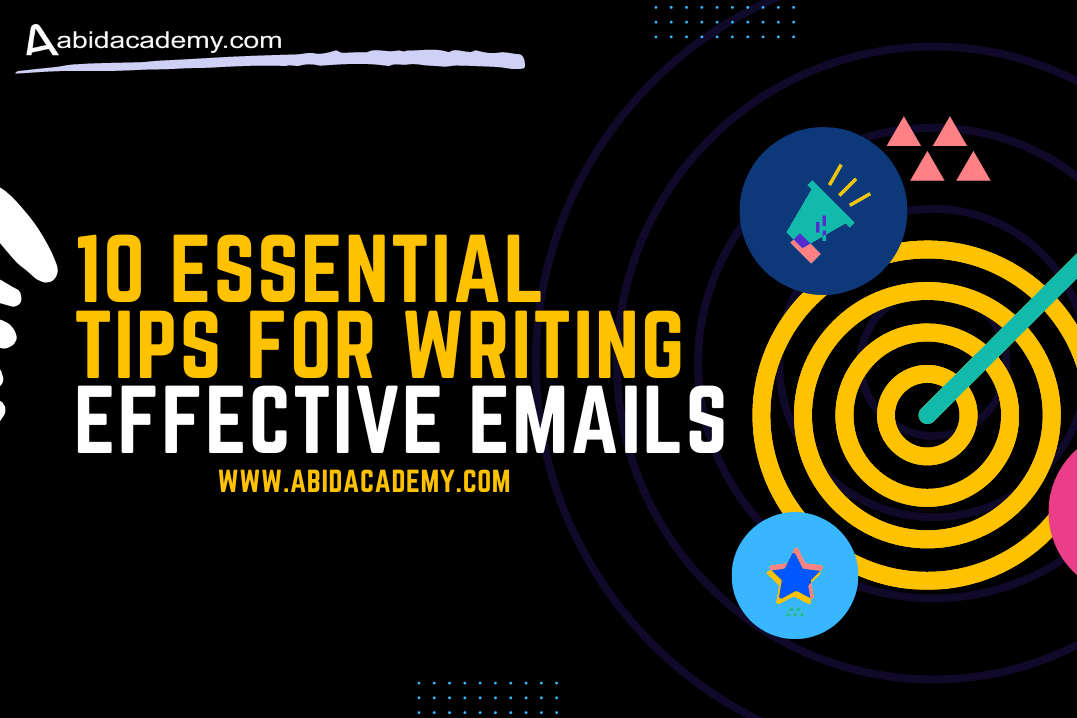
10 Essential Tips for Writing Effective Emails
Emails have become a ubiquitous form of communication in the modern world, whether for personal or professional use. In order to get the most out of this communication tool, it is important to follow certain guidelines and best practices to ensure that your emails are clear, concise, and effective.
In this article, we will be discussing 10 essential tips to help you write effective emails, starting from email etiquette to crafting the perfect email signature.
Table of Contents
How to Write Clear and Concise Emails
When writing an email, it is essential to get straight to the point. The recipient should be able to understand the purpose of the email within a matter of seconds. To ensure that your emails are clear and concise, try to keep them short and to the point, use bullet points where necessary, and avoid using technical jargon that the recipient may not be familiar with.
Additionally, it is important to consider the recipient’s point of view. Ask yourself what information they need and how you can provide it in the most efficient manner. This will help you write emails that are not only clear and concise but also effective in achieving their intended purpose.
The Dos and Don’ts of Email Subject Lines
The subject line of an email is often the first thing that the recipient sees, and it is therefore crucial in determining whether the email will be opened or not. When writing subject lines, keep them short and to the point, and make sure they accurately reflect the content of the email.
It is also important to avoid using misleading subject lines, as this can damage your professional reputation and result in the recipient losing trust in your emails. Additionally, avoid using all caps or excessive punctuation, as this can come across as spammy.
How to Write Professional Effective Emails That Get Results
Writing professional emails is a crucial aspect of communication in today’s business world. Whether you are sending an email to a colleague, a client, or a supervisor, the content and tone of your message can have a significant impact on your relationships and your ability to achieve your goals. In order to write effective, professional emails that get results, there are several key strategies to keep in mind.
First and foremost, it’s important to be clear and concise in your messaging. This means avoiding lengthy, meandering sentences and getting straight to the point. Start your email by clearly stating the purpose of your message, and use bullet points or numbered lists to break down complex information into manageable chunks. This not only makes your message easier to read, but it also helps your recipient quickly understand what you’re trying to communicate.
Another important consideration is email etiquette. This includes using a professional email signature, using appropriate salutations and closing statements, and avoiding slang or informal language. It’s also important to be mindful of tone when writing emails – while it’s okay to be friendly and approachable, it’s important to maintain a level of professionalism at all times.
When crafting your emails, it’s also important to keep your audience in mind. Who are you sending the message to, and what do they need to know? What are their goals and concerns? By taking the time to understand your audience, you can tailor your messaging to meet their needs and increase the chances of your email being well-received.

Finally, it’s important to proofread your emails carefully before sending them. Typos, grammatical errors, and other mistakes can detract from the professionalism of your message and give the impression that you’re not paying attention to detail. Take a few extra moments to carefully review your message before hitting “send” to ensure that it’s polished and error-free.
Writing professional emails that get results requires careful attention to detail and an understanding of what works best in this medium. By being clear, concise, and mindful of your audience and tone, you can craft messages that are effective and professional, helping you achieve your goals and build strong relationships with your colleagues, clients, and supervisors.
How to Write an Effective Email Introduction
The introduction of an email is the first opportunity to grab the recipient’s attention and convey the purpose of the email. In order to write an effective introduction, make sure to clearly state the purpose of the email and provide a brief overview of the content.
Additionally, it is important to build a connection with the recipient by addressing them by name and showing appreciation for their time and attention. This will help to establish a positive tone for the rest of the email and increase the likelihood of the recipient engaging with its content.
The Art of Crafting the Perfect Email Signature
Your email signature is an important part of your email and is often the first thing people will see after reading your message. It is a chance to make a good impression and leave a lasting impact on your recipient. Here are some tips for crafting the perfect email signature:
- Keep it simple: A clean and simple signature is more effective than a cluttered one. Stick to your name, job title, and contact information.
- Include your company name: This is especially important if you represent a company or organization. It helps to reinforce your brand and provides context for your recipient.
- Add a professional headshot: Adding a professional headshot to your signature can help personalize your emails and make a strong first impression.
- Use your brand colors: Incorporating your brand colors into your signature is a great way to reinforce your brand identity. This can be as simple as adding your brand color to your name or as elaborate as creating a full-color signature with your company logo.
- Include social media links: If you have active social media accounts, consider adding links to your signature. This gives your recipient the opportunity to connect with you on other platforms.
- Be consistent: Make sure your signature is consistent with your overall brand and messaging. This will help to reinforce your brand and make a lasting impression.
- Make it mobile-friendly: With the increasing use of mobile devices to check email, it is important to make sure your signature is mobile-friendly. This means it should be easy to read and navigate on smaller screens.

By following these tips, you can create a professional and memorable email signature that leaves a lasting impact on your recipients.
How to Write Effective Follow-Up Emails
Follow-up emails are an essential part of professional communication, but they can be tricky to get right. Here are some tips to help you write effective follow-up emails:
- Keep it brief: Follow-up emails should be brief and to the point. Your recipient is likely busy and doesn’t have time to read a lengthy message.
- Be polite: Follow-up emails should always be polite and respectful. Avoid using aggressive language or making demands.
- Provide context: Make sure to provide context for your follow-up email. This helps your recipient understand the purpose of the email and provides them with the information they need to respond.
- Be specific: Be specific about what you are following up on and what action you would like your recipient to take. This will help them understand what you need from them and make it easier for them to respond.
- Use a clear subject line: Use a clear and concise subject line that accurately reflects the content of your email. This makes it easier for your recipient to find and prioritize your message.
- Be patient: Follow-up emails can take time to receive a response. Be patient and avoid sending multiple follow-up emails in a short period of time. This can be perceived as aggressive and can damage your relationship with your recipient.
By following these tips, you can write effective follow-up emails that are respectful, informative, and actionable.
The Importance of Proofreading Your Emails Before Sending
Proofreading your emails is crucial before sending them, and there are a few reasons why. The first and most important is that it helps you avoid making any embarrassing mistakes or typos that could make you look unprofessional. It also helps you to catch any errors or inaccuracies in your message, which can help ensure that your message is understood correctly.
It’s essential to take the time to proofread your emails before sending them, especially if you’re sending an email to someone important, such as a potential client or your boss. Taking the extra time to double-check your work shows that you take your email communication seriously and that you value the recipient’s time.
When proofreading your emails, it’s best to read through the entire message from start to finish. This will help you catch any errors or typos that may have slipped your mind when you first wrote the email. If possible, it’s also helpful to read the email out loud, as this can help you catch any mistakes that you may have missed when reading silently.
In addition to checking for spelling and grammatical errors, it’s also essential to make sure that your email is formatted correctly. This includes checking the font, spacing, and margins to ensure that your email looks professional and easy to read.
Emailing a Stranger: How to Make a Good First Impression Through Email
Emailing a stranger can be a great way to make a good first impression and establish a relationship. When emailing a stranger, it’s important to make a good first impression by being professional, polite, and concise.
Start your email with a brief introduction that states the purpose of the email. Then, get straight to the point and provide the information that the recipient needs to know. Make sure to include any relevant details, such as the purpose of the email, to help the recipient understand why you’re emailing them.

It’s also important to be polite and professional when emailing a stranger. Avoid using language that could be perceived as aggressive or demanding, as this can make the recipient feel defensive and less likely to respond to your email.
When emailing a stranger, it’s also essential to make sure that your email is well-written and easy to understand. This includes checking for spelling and grammar errors, as well as making sure that your email is formatted correctly.
Emailing Your Boss: How to Write Emails That Show Respect and Professionalism
Emailing your boss can be a delicate task, as you want to show respect and professionalism while also effectively communicating your message. Whether you’re seeking clarification on a project, requesting time off, or providing an update, it’s important to take the time to craft your email in a way that demonstrates your professionalism and respect for your boss’s time and position. Here are some tips to help you achieve this.
First and foremost, it’s important to use a professional tone in your emails to your boss. This means avoiding slang, emoticons, and overly casual language, and instead using a more formal and professional tone. It’s also important to be mindful of your language and tone when discussing sensitive or potentially controversial topics, as you don’t want to come across as confrontational or unprofessional.
In terms of content, it’s important to be clear and concise when emailing your boss. Start your email by stating the purpose of your message and get straight to the point. Avoid lengthy, meandering sentences, and use bullet points or numbered lists to break down complex information into manageable chunks. This not only makes your message easier to read, but it also helps your boss quickly understand what you’re trying to communicate.
When emailing your boss, it’s also important to be mindful of their time and priorities. Consider the best time to send your email, and make sure that your message is relevant and important. Avoid sending emails just to check in, and instead focus on providing information that is critical to your boss’s work or decision-making process.

Finally, it’s important to proofread your emails carefully before sending them. Typos, grammatical errors, and other mistakes can detract from the professionalism of your message and give the impression that you’re not paying attention to detail. Take a few extra moments to carefully review your message before hitting “send” to ensure that it’s polished and error-free.
Emailing your boss requires a careful balance of respect, professionalism, and clear communication. By being mindful of your tone and language, being clear and concise in your messaging, and being respectful of your boss’s time and priorities, you can craft emails that demonstrate your professionalism and help you achieve your goals in the workplace.
5 Email Etiquette Rules Everyone Should Follow
- Respond promptly to emails
- Use a professional email address
- Avoid using all caps or exclamation marks
- Proofread before sending
- Use a courteous and respectful tone
Email etiquette is crucial in establishing and maintaining professional relationships. Responding promptly to emails shows that you value the recipient’s time and are responsive to their needs. Additionally, using a professional email address that includes your name and relevant information makes it easier for others to identify and reach you.
It is also important to avoid using all caps or excessive exclamation marks in your emails, as this can come across as aggressive or rude. Before sending any email, take a few minutes to proofread it and make sure it is clear, concise, and free of any errors. Finally, remember to use a courteous and respectful tone in your emails, regardless of the recipient or the subject matter.
Conclusion
In conclusion, writing effective emails is a valuable skill that can help you communicate more efficiently and professionally in the workplace. By following the tips and guidelines outlined in this article, you can improve your email writing skills and make a better impression on your colleagues, boss, and clients. Whether you’re composing a formal email to your boss or a more casual message to a colleague, it’s important to take the time to craft a well-written and thoughtful email that clearly conveys your message. With these tips in mind, you can write emails that are clear, concise, and effective, helping you to communicate more effectively and build strong relationships in the workplace.
FAQs
What are the most important things to keep in mind when writing an email?
When writing an email, it’s important to keep in mind the recipient, the subject matter, and the tone of the message. You should also make sure to proofread your email before sending it, to catch any mistakes or typos. Additionally, be mindful of the subject line and introduction, as these are the first things the recipient will see and can make a big impact on the success of your email.
How do I write a professional email to my boss?
When writing an email to your boss, it’s important to adopt a formal tone and show respect and professionalism. Make sure to proofread your email carefully and avoid using slang or casual language. You should also take the time to consider the subject matter and make sure your email is clear and concise.
What are the dos and don’ts of email subject lines?
When writing an email subject line, it’s important to make sure it is clear and concise, and that it accurately reflects the content of the email. Avoid using all capital letters or excessive punctuation, as this can make your email seem unprofessional. Additionally, don’t use vague or misleading subject lines, as this can frustrate the recipient and undermine the success of your email.
How can I write an effective email introduction?
An effective email introduction should be clear, concise, and engaging. Start by introducing yourself and explaining the purpose of your email. Be sure to keep the introduction short and to the point, and avoid using complex language or lengthy explanations. You can also use humor or personal anecdotes to make a connection with the recipient and increase the chances of your email being read and responded to.
What is the importance of proofreading your emails before sending them?
Proofreading your emails before sending them is important for several reasons. First, it helps to catch any mistakes or typos, which can make you appear unprofessional. Additionally, proofreading your email allows you to check that your message is clear and concise and that it accurately conveys your intended meaning. By taking the time to proofread your emails, you can improve your chances of communicating effectively and building strong relationships in the workplace.



